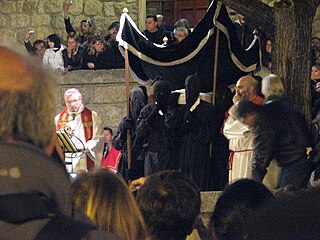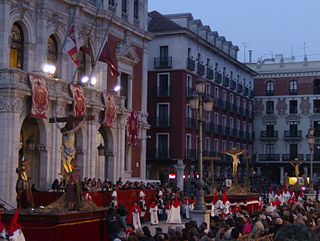
Zamora is a city in Castile and León, Spain, the capital of the province of Zamora. It lies on a rocky hill in the northwest, near the frontier with Portugal and crossed by the Duero river, which is some 50 kilometres (31 mi) downstream as it reaches the Portuguese border. With its 24 characteristic Romanesque style churches of the 12th and 13th centuries it has been called a "museum of Romanesque art". Zamora is the city with the most Romanesque churches in all of Europe. The most important celebration in Zamora is the Holy Week.

A Holy Week procession is a public ritual march of clergy and penitents which takes place during Holy Week in countries which have a Catholic culture. Various images of the saints, especially the Virgin Mary, and most importantly the image of the crucified Christ are carried aloft by foot as a penance; acts of mortification are carried out; traditional hymns and chants are sung. In many penitential orders, the faces of the penitents are covered by elaborate hoods, such as the capirote, as a way of hiding one's identity in order to not ostentatiously draw attention to oneself while performing penance. Crosses, and biers holding Catholic holy images surrounded with flowers and offerings of candles, are carried usually from one parish church to another led by the clergy, monastic orders, or heads of the penitential orders.
Cuyotenango is a town and municipality in the Suchitepéquez department of Guatemala.

Hellín is a town and municipality located in the south of the province of Albacete, in Castile-La Mancha, Spain. As of 2012, it has a population of 31,262.

Holy Week in Seville is known as Semana Santa de Sevilla. It is one of the city’s two biggest annual festivals, the other being the Feria de Abril, which follows two weeks later. It is celebrated in the week leading up to Easter, and features the procession of pasos, floats of lifelike wooden sculptures of individual scenes of sorrowfull Mysteries of the Rosary, or images of the grieving Virgin Mary.

Hoyos is a municipality located in the province of Cáceres, Extremadura, Spain. According to the 2005 census (INE), the municipality has a population of 988 inhabitants. It is the administrative capital of the Sierra de Gata.

The saeta is a revered form of Spanish religious song, whose form and style has evolved over many centuries. Saetas evoke strong emotion and are sung most often during public processions.

Holy Week in Spain is the annual tribute of the Passion of Jesus Christ celebrated by Catholic religious brotherhoods and fraternities that perform penance processions on the streets of almost every Spanish city and town during the last week of Lent, the week immediately before Easter.
The title of Fiesta of International Tourist Interest is an honorary distinction of being given in Spain by the General Secretariat of Tourism of the Ministry of Industry, Tourism and Trade of the Government of Spain, granted to the fiestas or events involving manifestations of cultural and popular tradition, with particular regard to their ethnic characteristics and special importance as tourist attractions. This honorary title is held by 30 fiestas in Spain.
Semana santa en Acapulco is a 1981 Mexican film. It was directed by Luis Alcoriza.

Holy Week in Viveiro is one of the most important traditional events of Viveiro, Spain. It is celebrated in the week leading up to Easter, and is one of the best known religious events within Galicia. As a reflection of its importance, is also considered as a Fiesta of International Tourist Interest of Spain since 2013.

Holy Week in Mexico is an important religious observance as well as important vacation period. It is preceded by several observances such as Lent and Carnival, as well as an observance of a day dedicated to the Virgin of the Sorrows, as well as a mass marking the abandonment of Jesus by the disciples. Holy Week proper begins on Palm Sunday, with the palms used on this day often woven into intricate designs. In many places processions masses and other observances can happen all week, but are most common on Maundy Thursday, Good Friday, Holy Saturday and Easter Sunday, with just about every community marking the crucifixion of Jesus in some way on Good Friday. Holy Saturday is marked by the Burning of Judas, especially in the center and south of the country, with Easter Sunday usually marked by a mass as well as the ringing of church bells. Mexico's Holy Week traditions are mostly based on those from Spain, brought over with the Spanish conquest of the Aztec Empire, but observances have developed variations in different parts of the country due to the evangelization process in the colonial period and indigenous influences. Several locations have notable observances related to Holy Week including Iztapalapa in Mexico City, Taxco, San Miguel de Allende and San Luis Potosí.

The Passion Play of Iztapalapa is an annual event during Holy Week in the Iztapalapa borough of Mexico City. It one of the oldest and most elaborate passion plays in Mexico as well as the best known, covered media both in Mexico and abroad. Unlike others in Latin America, its origins are not in the colonial period but rather a cholera epidemic in the 19th century, which gave rise to a procession to petition relief. Over time, the procession included a passion play which grew over time to include various scenes related to Holy Week. Today, the play includes not only hundreds of actors, but also thousands of men called “Nazarenes” who carry their own crosses to follow the actor chosen to play Jesus to the site where the crucifixion is reenacted. While the event is still primarily religious, it has also become a rite of identity for Iztapalapa as well as a major tourism attraction for both the borough and the city.
The Penitential Brotherhood of the Holy Eucharist, founded on May 6, 1959, is one of nine religious brotherhoods of the city of Bilbao that take part in its Holy Week. Bilbao is the most important place for the Holy Week in Spain in the northern part of the country, but not as well known as the Holy Week in Seville. It is canonically headquartered at the Jesuit School, so it is popularly known as the Jesuit Brotherhood. It consists of current and former students, as well as family and friends, but also of people outside the school.

The Penitente Hermandad de Jesús Yacente is a brotherhood in Zamora, Spain, important in its Holy Week; they parade solemnly on the night of Holy Thursday.

The Holy Week in Valladolid is one of the main tourist attractions, and cultural and religious events of Valladolid and the surrounding province during Holy Week in Spain. It boasts of renowned polychrome sculptures, created mainly by sculptors such as Juan de Juni and Gregorio Fernández, who were active when the city served as the imperial court. The city's National Sculpture Museum has a total of 42 images for the processions. The Holy Week in Valladolid is known to depict the Passion with great fidelity, rigor and detail.

Holy Week in Cuenca is the most important religious event of Cuenca, Spain. It is celebrated in the week leading up to Easter. As a reflection of its cultural, historic and spiritual importance, Holy Week in Cuenca was declared Fiesta of International Tourist Interest of Spain.
Procession at Seville and bullfighting Scenes is a non-fiction short film created by Auguste and Louis Lumière between 1898 and 1899. The Lumière brothers used a cinematograph to film this motion picture in Seville, Spain.

Holy Week in Malaga, is the annual commemoration of the Passion of Jesus Christ that takes place during the last week of Lent, the week immediately before Easter. It is one of the main cultural events, religious and tourist attraction of Málaga.
Holy Week is commemorated each year in Santa Cruz de La Palma, Canary Islands, by processions marking the Passion, Death and Resurrection of Jesus Christ. It is one of the oldest festivities in the island of La Palma, and is the most significant public religious event that takes place in the city, except for the Lustral Festivity of the Bajada de la Virgen. In 2014 it was declared a Fiesta of Tourist Interest in the Canary Islands.













